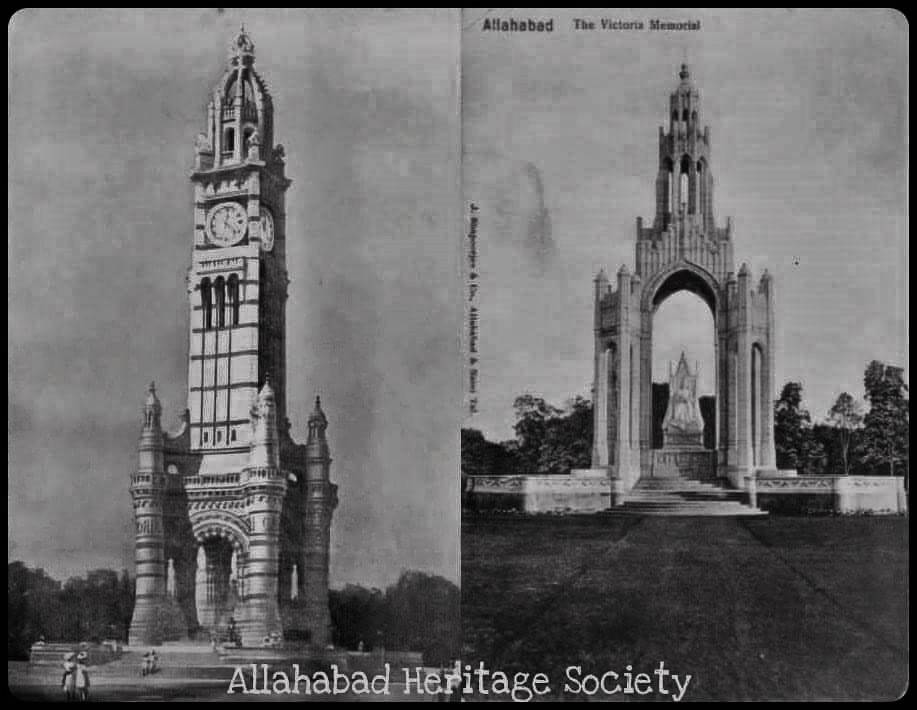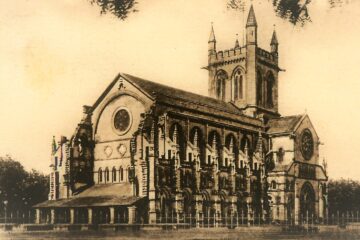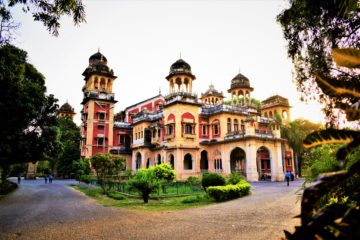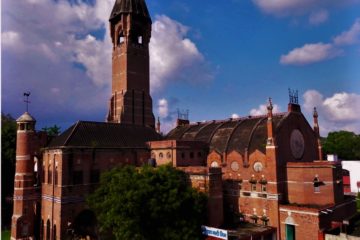The Story of Allahabad: Culture & Civilization
Published by admin on
The Story of Allahabad
Written by : Akshat Lal,
President : Allahabad Heritage Society

Allahabad is said to be one of the oldest pilgrimage site in India. It has been a meeting point of vivid cultures and traditions. The great Indian civilization which flourished by the plains of Ganga took this region in its grip to develop it into an ancient pilgrimage site.. Through ages, Prayag has been an epicentre of various cultures coming together and blending into one. From the ancient times, Prayag was the seat of hermits and sages. It was their ground of penance which has immense value in Hinduism and Jainism. It has been a religious place not just because of the confluence of Ganga, Yamuna and the invisible Saraswati but also because great thinkers and religious leaders understood it’s importance and contributed in building it’s culture. Vedas and Ramayana mention that Sage Bharadwaj had his ashram here. He had the honour of being host to Lord Rama and has given massive treatise on Hinduism. The first Jain tirthankar, Lord Rishabhadev also penanced in Prayag. Therefore Jainism also flourished was consolidated hereafter the death of Lord Mahavira. In the times of Mahabharat, Vatsa empire built it’s capital in the vicinity of Prayag, and called it Kaushambi. This was the great seat of learning in ancient times and had the distinction of being a place where Lord Buddha visited on multiple occasions to give sermons. Ashoka also gave importance to this place and in his times Kaushambi was considered to be a city which had a lot of cultural value.
In the period after the Christ, King Harshavardhana considered this place to be the great seat of learning and organised massive fairs on the banks of the confluence of Ganga and Yamuna. This can be testified from the accounts of the great Chinese traveller, Hieun Tsang who visited this place with the king and his retinue. This ancient fair can be considered to be the roots of what is now known as the Kumbha Mela. It was in this grand fair that people from all corners of Bharat visited this place and exchanged ideas which helped in building the consolidated culture of not just Prayag but the whole Hindu civilization. Therefore it can be historically testified that Prayag had the distinction of being a great site for the evolution of Sanatan Dharma. In the age of Bhakti Cult, Allahabad remained an important cultural centre. Saints like Chaitanya Mahaprabhu, Kabir and Tulsidas also visited this place and contributed in its cultural synthesis.
In the Muslim era, Kara flourished as the administrative centre and it’s culture reached it’s zenith when Emperor Akbar ruled India. He built his great fort near Sangam and established a new city on the west of the fort. Mughals helped a lot in the development of this city and it’s vivid culture. They gave some great monuments to this city. Sufism also developed here, when great muslim thinkers like Shah Muhibullah established his Khanqah in the city. Shah Muhibullah was very popular in Arab and Iran because of his important contribution in the muslim literature and spiritual writings. He was also considered to be a great influence for Mughal Prince Dara Shikoh, the eldest son of Emperor Shah 1Jehan. Areas like Khuldabad, Chowk, Yahiyapur, Dariyabad flourished in medieval times. The Great Road or Sadak-e-Azam (now GT Road) passed through chowk. There were at least eighteen big caravanserais on this road and equally busy market which was then compared to Chandni Chowk. Persians were also aware of the grandeur of Chowk and Khuldabad. Rich Khatri merchants also settled in the vicinity of Chowk. Many zamindars and taluqdars also settled down in Allahabad in the muslim era. The rich Hindu class of the city had its huge share in the development of the blended culture of the city. They started organising Ramleela and Dusshera processions on large scale. The muslim zamindars also started organizing Moharram processions, but there was no rivalry between Hindus and Muslims of that age. In fact there are instances when the two communities helped each other in their festivities. The amalgamated Urdu culture, better known as the Ganga-Jamuni tehzeeb or the diverse culture of Hindu-muslim unity held this city together for ages to come.
After, the Sepoy Mutiny of 1857, when British made this city their administrative centre, Allahabad became one of the premiere cities of not just the United Provinces but the whole India. It was made the capital of the Province and High Court was established here. Later British established an Anglican University in the city. Right after these developments, the city changed its nature and once again it bloomed as an educational town. Great academicians, laureates, poets and writers made this city their hometown. Allahabad was the first city to be planned by British on such a large scale. They developed the Civil Station and called it Cannington. This area had roads being made on a grid iron plan. There were clubs, theatres, libraries, gardens, open bars, parks, cathedral, government institutions, tree lined avenues, multinational shops and markets only for the needs of high class Anglicans. This was the first time that Allahabad became a cosmopolitan city of India.
It was in the early 20th Century that Allahabad became a fully-developed city of Anglo-Indians. There were a considerable number of Anglicans in the city. It happened because Allahabad became the base of the North Central Railways which had the highest number of Anglo-Indians employed. There was High Court, Army base, a number of English medium schools and colleges which acted as reinforcement for their settlement in Allahabad. Various missions and branches of Christianity like the American Presbyterian Mission, Pentecostal Church Mission, Anglicans, Roman Catholics, and Evangelicals were introduced in Allahabad and this consolidated their hold in the city. The bungalow culture was born because of the Anglicans of this city and later, it became popular in the rest of the country. It is being said that Allahabad was the blueprint for the newly developed Lutyen’s Delhi.
Writers of English, Hindi and Urdu loved this city because of its peaceful environment and diverse literary culture. Rudyard Kipling, Tagore, Premchand, Firaq Gorakhpuri, and many such writers lived in Allahabad for long. They never belonged to this city but loved the literary environment of this place. Great Urdu writer of the age, Ibn e Safi also belonged to Allahabad and started his literary career from the city but migrated to Pakistan after Independence. On the other hand, great hindi writers like Suryakant Tripathi ‘Nirala’, Sumitranandan Pant, Harivansh Rai ‘Bachchan’, Mahadevi Verma, Subhadra Kumari Chauhan, Dharamveer Bharati, Upendranath Ashk and many others belonged to this city and lived here to carry the baton of deep literary culture which Allahabad had. This led to the development of many big printing presses. The Indian Press, Pioneer Press, and Belvedere Press needs special mention.
Celebrated globe-trotter Mark Twain visited Allahabad and was fascinated by the serenity of this place. He gave a detailed account of the rich and varied culture of Allahabad. He was in love with the greenery of this place. Another great British historian and Indologist, Vincent A. Smith visited Allahabad to witness the great Kumbh Fair. He gave a beautiful description of Kumbh and the rich heritage of the Mela and the way people exchanged great ideas in the fair. Many other British and American writers and travelers visited Allahabad to witness its rich and diverse culture and to notice the elements of superiority which this city boasted of having in relation to other cities of India.
The peaceful and diverse ambiance of this city attracted many outsiders to come here and settle down. Many Kashmiris started living here. Prominent families like those of Nehrus and Saprus made this city, their hometown. Motilal Nehru and his son Jawaharlal Nehru were the torch-bearers of the Indian Freedom Struggle and the Indian National Congress. It was because of the Nehrus that many national and international political figures including Mahatma Gandhi visited Allahabad on many occasions. The High Court of Allahabad had its jurisdiction over the whole of United Provinces which was the largest in the country; and it was because of this factor, the city of Allahabad was known as a Lawyers’ Paradise. Many prominent legal luminaries of India settled down in Allahabad and this changed the very culture of this place. The high class clubs and theatres were always full of great intellectuals who loved this city like no other place in the country.
This city also had some popular Parsi families who contributed a lot in the development of the grand Allahabadi culture. Families like that of Ghandhis, and Patells and Dhondys will always be remembered in the history of Allahabad. The Ghandhis even owned a Parsi Temple in the city which was called, ‘Lejar Shapoorjee Ghandhi Dar-e-Maher’ and this family has always managed to keep the fire of the temple (known as ‘Aatish Behram’) burning for these many decades. The Sikhs too, lived in Allahabad in the vicinity of Meerapur and Punjabi colonies. They have a Gurudwara in Yahyapur called Pakki Sangat which is considered to be the same place where Guru Tegh Bahadur visited with his wife and Guru Govind Singh was conceived here.
The Hindu Kayastha community which was known to be the ministers of many muslim rulers remained as land owners even in the British times. Many such families settled down in Allahabad. Special mention should be made of the families of Chaudhary Mahadeo Prasad, Kali Prasad, Raj Bahadur and Munshi Asharfi Lal. Zamindars from other communities who had their land in the adjoining areas of Allahabad also settled down in Allahabad. Popular families like that of the Raja of Manda, Raja of Shankargarh, Zamindar of Anapur, and many others started living in the city. They added to the rich culture of the city. Huge tea parties and evening parties were arranged at these houses in which the intellectual class and the ruling class exchanged ideas and helped in the modernisation of the city culture.
The cultural fabric of Allahabad has threads of all the various communities of India. It is as strong as a Banyan Tree with its roots deeply rooted in the history of India. Allahabad has been a religious town, a spiritual place, an educational seat, a cantonment town, a capital, a literary hub, lawyers’ paradise, political nursery and still manages to retain it’s peacefulness and serenity. It is a land of vividness and not just the confluence of Ganga, Yamuna and Saraswati but the confluence of various rich cultures. One can experience a cultural blend of the Hindu-Muslim rich heritage and the colonial grandeur at the same time in Allahabad. This city will always be considered as vanguard of culture, literature, academics and politics. It won’t be wrong to keep this city in the list of great historical cities like Athens, Rome or Istanbul.




0 Comments